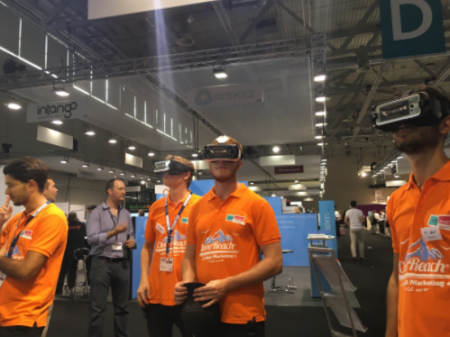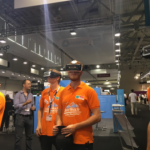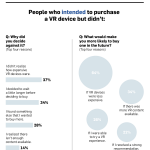For marketers, virtual reality offers real potential and opportunities
For marketers, virtual reality offers real potential and opportunities

Is Virtual Reality a disruptive technology or all hype? This is the question that launched a thousand think pieces, yet even the most jaded VR cynic must admit that something feels different about this iteration of the VR boom.
Perhaps it’s the pervasiveness of the technology in popular media — it played a key plot point in the past season of HBO’s “Silicon Valley,” it was featured in Samsung’s Super Bowl commercial, and it was marketed as a way to enjoy Coachella from the comfort (and cleanliness!) of your own home. Or perhaps it’s the rosy financial outlook offered by respected research firms – Goldman Sachs predicts AR/VR will be an $ 80 billion industry by 2025 and IDC forecasts 100 million AR/VR headsets will be sold in 2021, a 10 times increase over last year’s sales. Maybe it’s that anyone can access and create VR easily with recent advances, like 360-degree cameras and authoring/publishing platforms.
See also: 5 effective and smart ways to do VR marketing today
One indisputable fact is that growth in the industry is dependent on content. And not just any content, but content that leverages the inherent benefits of 360-degree immersion, and demands to be seen and heard. If there’s one thing that will stop VR growth in its tracks, its lack of quality experiences to download, stream, or purchase.
Enter the marketers
The same marketers currently creating 30-second TV ads will play a major role in shaping VR. Though the term “branded experience” gets thrown around often in marketing and advertising conference rooms, rarely does it find a better fit than VR — Lionsgate’s VR trailer for their new iteration of Blair Witch, for example, captured the attention of its audience. The heightened emotional response of horror movies dovetails nicely with the excitement of immersion in an unfamiliar world.
For a marketer new to VR, there is some expected trepidation. What kind of new equipment will I need to buy? Will I need to learn how to code or outsource to expensive engineers for the end deliverable? How will I pitch this new technology to clients?
The reality is that creating VR is not difficult. With the prevalence of 360-degree cameras on the market, and web-based software like the InstaVR platform, any marketer with an internet connection can generate VR content today. Everything can be done in-house, no outsourcing or coding required. As for client acquisition, VR’s applicability traverses many different types of businesses. Almost all existing clients will have experienced VR at some point, so the pitch really comes down to how and when to leverage the technology.
Left of Creative, a digital agency that has been doing multimedia productions for over 20 years, created an immersive 360-degree video tour for the U.S. Navy supercarrier U.S.S. Carl Vinson to showcase a VR app during this year’s Sea-Air-Space Exposition — the largest maritime exposition in the United States. Visitors to the exposition got an inside look at the ship in action via Samsung Gear VR headsets. The capture and authoring for the VR application was done primarily using a Gear 360 camera, a laptop, and an authoring platform, proving just how easy it is for marketers to adapt to VR.
New marketing revenue streams
Just as social media has created a new revenue stream for many marketing agencies, so too has virtual reality. Smaller VR-specific agencies are forming, while larger marketing firms are dedicating whole groups to the emerging technology. And with VR not quite reaching mainstream status yet, there’s a novelty and excitement around virtual reality that is palpable in clients. In a world of 600 TV channels and seemingly millions of YouTube stars, creating a shareable, unique, exceptional VR experience has a lot of value in cutting through the noise.
As with traditional web media, there are ad networks dedicated solely to generating traffic to VR experiences and monetizing them. For metrics-driven marketers, you can tie your VR media to Google Analytics to measure engagement, and heat map overlays can show you what areas of your VR experience are most popular. You can even turn a VR application into a direct response vehicle – with APIs able to pull up a phone number to call at the conclusion of a mobile VR app.
VR is also a global phenomenon, allowing marketers to reach a geographically wide audience. If anything, North America lags behind portions of the developed world in terms of VR adoption. While not a totally greenfield opportunity, anyone getting into VR now still has a large addressable market that is still materializing. The Google daydream headset, for example, is slated to be compatible with over 10 million phones shipped this year.
As VR continues to disrupt hiring and training and education, marketing professionals should strongly consider investing in becoming VR-ready. If they’re not actively pitching the technology to their clients, their clients will soon be coming to them asking about it. And if the numbers from Goldman Sachs and IDC are to believed, AR/VR headsets will become fairly ubiquitous in the next decade. The question will then become — which marketers are creating the best VR content and helping their clients stand out?
The post For marketers, virtual reality offers real potential and opportunities appeared first on ReadWrite.
(38)












